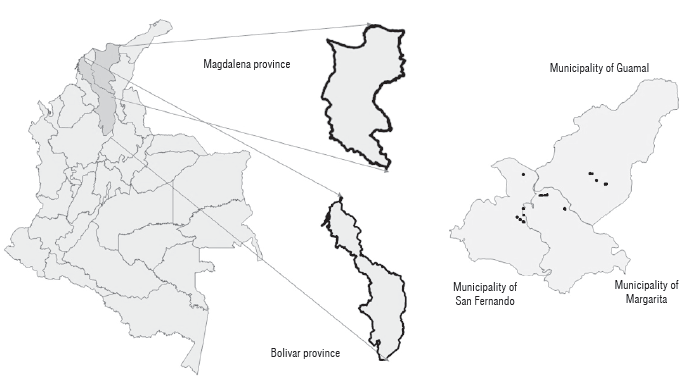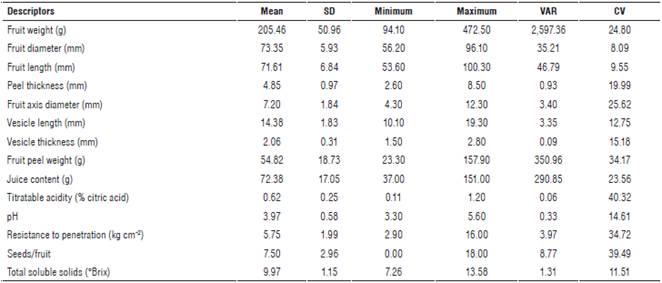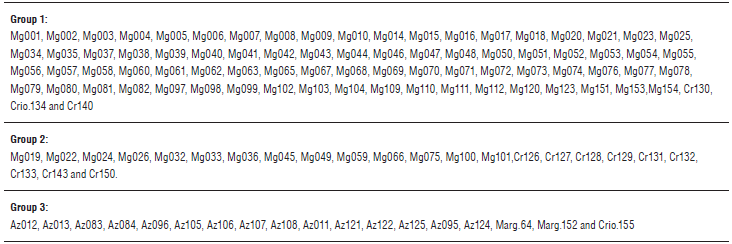Introduction
Citrus plants are native to the tropical and subtropical regions of Asia and the Malay Archipelago, and their commercial production is concentrated between 20° and 40° latitude in both hemispheres (Roose et al., 2015) incorporating an uncertain number of species (Albert et al., 2018). According to FAO, citrus plants are the main fruit crop cultivated worldwide reaching an approximate production of 139,796,997 metric t and a planted area of 9,080,780 ha in 2014 (FAO, 2004; FAOSTAT, 2014). During this same year in Colombia, the area planted with citrics was 97,275 ha with a production of 1,206,856 t per year, being orange the main cultivated citrus species with 54,711 ha of cultivated area that produced 669,187 t (ASOHOFRUCOL, 2016; ENA-DANE, 2016). Orange cultivation relies on the use of different clones such as Valencia and Sweety, and in smaller areas clones such as Salustina, Hamlin and various selections of Criollo materials are used (Orduz and Mateus, 2012; Ramírez et al, 2014).
Among the Criollo materials the Margaritera orange stands out; it is grafted on bitter orange (Citrus aurantium L.) tree rootstock. Margaritera orange has been bred according to the necessities of the region's producers, finding three clones: Margarita, Azúcar and Criollo. These bred lines differ in their acidity concentrations and total soluble solids, being the Azúcar clones the ones that showed the lowest acidity and the highest total soluble solids. These clones are adapted to the edaphoclimatic conditions of the Mompox depression region and its surroundings, where average monthly temperatures exceed 25°C all year round, daily minimum temperatures are rarely less than 20°C, and the maximums frequently exceed 32°C. The average bimodal annual rainfall (first peak in May and a second peak in October) decreases from 2,200 mm in the south and southeast, and in Cauca and Magdalena rivers to less than 1,000 mm where Loba and Mompox converge (García, 2001). Margaritera orange is cultivated mainly by small-scale producers in the municipalities of Santa Cruz de Mompox, San Fernando and Margarita in the province of Bolívar, and in Guamal, Santa Ana, San Zenón and San Sebastián in the south of the province of Magdalena; this orange has outstanding attributes of35.22% juice and good taste, making it attractive for domestic and export markets; however, despite the high acceptance of these clones by producers, basic aspects of their phenotypic variability are still unknown.
During the last winter season in 2010-2011, ca. 80% of the orange trees in some municipalities of the Mompox region were affected or destroyed by floods (Huertas et al., 2014; Agronet, 2017).This situation placed the genetic resource of the region at risk. Therefore, the objective of this study was to characterize and select high value Margaritera orange clones, with the purpose of providing propagation material for nurseries, so basic gardens can be established. Once these gardens are established, they can be used as a basis for repopulation in the region as they are part of the producers' subsistence economic strategy. Furthermore, the constant supply of plant breeding can increase the fruit consumption in the cities of the Caribbean coast.
Materials and methods
Phenotypic characterization of fruits from the selected genotypes
A recognition track was established in the Mompox depression in the municipalities of San Fernando, Margarita and Santa Cruz de Mompox in the province of Bolívar, and in the municipalities of Guamal and San Sebastián in the province of Magdalena, assessing the citrus fruits productive areas and identifying the crops lines that survived the harsh rainy season occurred in 2011. After analyzing the location data, a focused sampling was carried out, considering Margaritera orange trees as the bred line with higher productivity, better fruit quality, more vigorous and longer-life cycle. Twenty-five farms were visited selecting 120 tree genotypes (Fig. 1), and from these, five fruits of the middle third of the tree crown (one for each cardinal point and a randomly selected one) were chosen per tree. During collection, the fruits were selected following the quality criteria registered in the Icontec NTC4086 regulation (Icontec, 1997). Under these statements, whole fruits with specific features of the Valencia orange were selected. Such traits included: presence of the calyx, healthy tissues, and whole fruits without any symptoms of abnormal external humidity caused by poor postharvest management. The fruits should not have any external and strange smell and/or taste (stemming from other products, packages or recipients and/or agrochemicals that might have been in contact with the fruits). Fresh fruits should also have a firm consistency and be free of any visible strange materials (such as dirt, dust, agrochemicals and foreign objects). Each genotype was codified according to the producer's criteria as follows: a Margarita (Mar) clone, an Azúcar (Azuc) clone or a Criollo (Crio) clone. The fruits were then analyzed in the laboratory using 14 quantitative descriptors for Citrus spp. published by IPGRI (2000). For the information analysis, a completely randomized design with 120 treatments and five replicates was used, in which treatments corresponded to the trees sampled and the replicates corresponded to the fruits per tree.
Selection of outstanding clones
A selection index (SI) with standardized variables (mean = 0 and variance = 1) that included variables such as juice percentage (JP) and maturity index (MI) was established; this last one is a variable obtained from the relation between total soluble solids (TSS) and titratable acidity (TA); these are the main attributes considered when orange is commercialized in the agro-industrial markets. According to the Colombian Technical Standards Institute (Icontec) regulation (NTC4086), for the commercialization of Valencia orange (maturity stage I), the desired TSS concentration is 8.2 °Brix, TA of 1.5% citric acid, MI of 5.5 and a JP higher than 40%. Therefore, and after fulfilling the required attributes, the SI (described in equation 1) was established. According to the SI, 7% of the genotypes that comprise the groups obtained in the phenotypic characterization were selected in order to maintain the best clones with the highest variability.
Equation 1:
Where:
SI: standardized selection index
JP: juice percentage (%)
MI: maturity index
Statistical analysis
Data obtained in the morpho-agronomic characterization were analyzed using the statistical program SAS® Enterprise Guide® version 5.1 (2012). A descriptive analysis (mean, standard deviation, standard error, coefficient of variation, minimum and maximum values) was carried out to establish the variability of the quantitative characteristics at the level of the selected and characterized trees; an ANOVA and Tukey test of multiple comparisons were also applied with the evaluated variables. A principal component analysis (PCA) was further carried out to establish the descriptors with the highest contribution to total variability. Next, the 120 genotypes were grouped with a cluster analysis obtaining relatively homogeneous groups (Franco and Hidalgo, 2003).
Results and discusion
Phenotypic characterization
The descriptive statistics such as averages, standard deviation, coefficient of variation and minimum and maximum values of the 120 genotypes of Margaritera orange collected are shown in Table 1. In general, the quantitative morphological characteristics showed a low coefficient of variation (CV<26%), except for the titratable acidity descriptors (CV = 40.32%), number of seeds per fruit (CV = 39.49%), resistance to penetration (CV = 34.72%) and fruit peel weight (CV = 34.17%); these are important when discriminating the variability of Margaritera orange genotypes. Moreover, the descriptors that showed lower coefficient of variation were fruit diameter length with 8.09% and 9.55% respectively. The characteristics that showed the highest dispersion values compared to their sampling means were: fruit weight that showed a minimum value of 94.10 g and a maximum value of 472.50 g; fruit peel weight with a minimum value of 23.30 g and 157.90 g as its maximum value; and fruit content with a minimum value of 37 g and a maximum value of 151 g. These values agreed with the ones reported by Duran and Luz (2013), who found fruit weights between 64.6 and 365 g in Valencia oranges cultivated in Chimicha-gua, department of Cesar.
Correlation analysis
The correlation matrix indicates associations that are statistically significant (P≤0.05) and highly significant (P≤0.01). The most outstanding correlations were fruit weight (FW) compared to: fruit length (FW vs. FL = 0.92**), fruit diameter (FW vs. FD = 0.87**), fruit peel weight (FW vs. FPW = 0.81**) and juice content (FW vs. JC = 0.76**). Meanwhile, the fruit peel weight reported an important correlation (FPW) with peel thickness (FPW vs. PT = 0.81**), fruit length (FWP vs. FL = 0.77**) and fruit diameter (FPW vs. FD = 0.74**). Equally important was the correlation between fruit diameter and fruit length (FD vs. FL = 0.88**), and fruit diameter with juice content (FD vs. JC = 0.67**). Finally, the correlation between fruit length with juice content (FL vs. JC = 0.70**), and titratable acidity with pH (TA vs. pH = -0.7**) were representative as well (Tab. 2).
TABLE 2 Pearson's correlation results for 14 quantitative fruit characteristics in Margaritera orange (Citrus spp.).
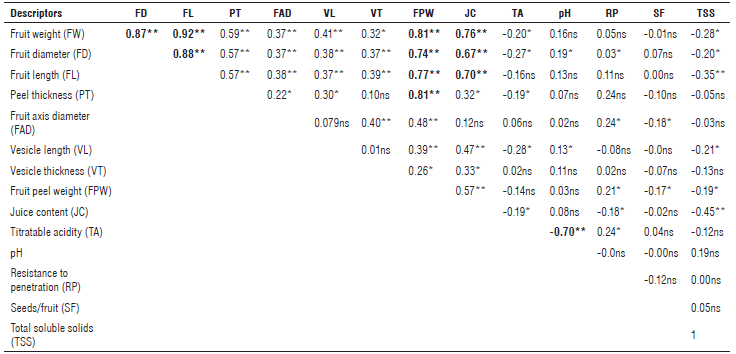
** Highly significant (P≤0.01); * significant (P≤0.05); ns: not significant (P>0.05); bold values indicate highly significant correlations (≤-0.6 and >0.6).
High correlations between the FW with fruit dimensions (FL and FD) and filling (FPW and JC) were expected. To support this statement, higher fruit dimensions, filling rates, and higher weight, were assessed as the physiological response of the accumulation of metabolites in the fruit development. This effect may be limited whether by the inability of the fruit to accumulate metabolites or by the lack of them within the plant (Agustí and Almela, 1991). Likewise, Bain (1958) characterized the general development pattern of the Valencia orange fruits in the subtropical conditions of Australia, as a simple sigmoidal curve from anthesis to maturation. The same trend was also described by several authors such as Pérez de Camacaro and Jiménez (2009) for the same species in a vegetable garden in the State of Portuguesa in Venezuela, Garzón et al. (2013) in the foothills of Llanos Orientales in Colombia, and Orduz et al. (2009) in Arrayana mandarin in foothill conditions in Meta.
Furthermore, the titratable acidity and pH showed a negative correlation; when higher juice pH was found, a lower titratable acidity was also found. These variables are related, as the titratable acidity measures the total acid concentrations which are mostly organic acids such as citric, malic, lactic and tartaric acids that influence flavor, color and juice stability. Moreover, pH quantifies H3O+ concentration which can be considered as active acidity. In this regard, this value is of great importance for food industries, because it determines the use and control of microorganisms and enzymes driving processes, such as the clarification and stabilization of fruit and vegetable juices, as well as fermented byproducts. In Table 2, Pearson's correlation data for 14 quantitative fruit characteristics in Margaritera orange are presented.
Principal component analysis
PCA showed that 78.82% of the variability was explained by five main or principal components (PC) (Tab. 3). The first PC explains most of the variability with 38.41%, followed by the second 13.50%, the third PC 11.19%, the fourth 8.24% and the fifth PC 7.48%.
TABLE 3 Contribution of quantitative variables to the conformation of the first five main components (PC) of the Margaritera orange (Citrus spp.) collected at the Mompox depression.
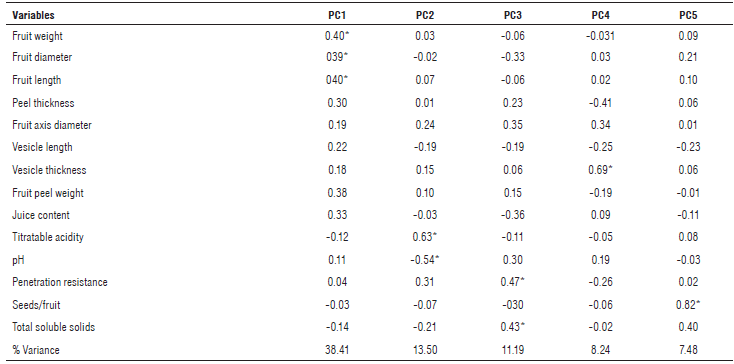
The descriptors with the greatest contribution to phenotypic variability in the first three principal components are mainly associated with fruit dimensions (fruit weight, diameter and length) and the chemical characteristics of the juice (titratable acidity, pH and total soluble solids); This results confirm what was stated by Goldenberg et al. (2018) and Agustí et al. (2003), in which the fruit size of a variety can vary between a wide margin and is regulated by a set of endogenous factors (genetic factors, fruit position, competition between different growing organs) and exogenous factors (environmental factors and cultural practices); Lado et al. (2018) and Reuther and Rios-Castaño (1969) described that juice acidity and total soluble solids are regulated by environmental conditions, mainly temperature. However, authors like Nii et al. (1970), Reuther (1973) and Yamanishi (1994) mention that the influence of temperature on total soluble solids (TSS) is not so clear; for example, in Valencia orange the highest TSS contents are obtained in fruits from subtropical areas, but the conclusion of many studies, combining thermal regimes, climates and crop zones in different fruit development states, is the lack of systematic response of the TSS content to the thermal variations.
Cluster analysis
Multivariate-cluster analysis generated three phenotypic groups (GI, GII and GIII) (Fig. 2). Group GI comprises 79 genotypes of which 93.6% belong to the Margarita clone and 6.4% belong to genotypes of the Criollo clone. Group GII is comprised by 23 genotypes of which 60.86% belong to the Margarita clone and 39.14% genotypes belong to the Criollo clone. Finally, group GIII comprises 18 genotypes, of which 80.33% are identified as Azúcar clones, 11.11% belong to genotypes of the Margarita clone, and one (1) genotype belongs to the Criollo clone (see Supplementary material 1).
Comparing characteristics of the groups comprised, significant differences were found (ANOVA≤0.05) with the exception of attributes: number of seeds per fruit and resistance to penetration. The GI genotypes are mainly characterized by having smaller fruits (FD = 70.92 mm and FL = 68.88 mm) and lower weight (183.73 g), lower MI (15.13) and higher JP (36.80%). On the other hand, the genotypes of the GII have larger fruits (FD = 79.59 mm and FL = 79.41 mm), lower weight (FW = 270.79 g) and lower JP (33.35%). Lastly, the GIII shows fruits with an intermediate size and weight compared to fruit characteristics found in GI and GII; this highlights the fact that the main attribute that identifies the genotypes of this group are the low titratable acidity of the juice and higher pH (TA = 0.21% citric acid and pH = 5.23), which is evidenced by the high maturity index (MI = 66.78) (Tab. 4).
TABLE 4 Descriptive analysis of fruit characteristics from the groups obtained in the phenotypic characterization.GI (79): group 1 with 79 genotypes; GII (23): group 2 with 23 genotypes; GIII (18): group 3 with 18 genotypes; CV: coefficient of variation.

Means with distinct letters indicate significant difference after the Tukey test (P≤0.05).
The results corroborate, to a great extent, the appreciations mentioned by producers, confirming the existence of three clones selected by organoleptic characteristics, also emphasizing that these attributes are maintained when asexual propagation is carried out. Quality attributes reported for the Margaritera orange cultivar are characteristic of Valencia orange cultivated in the tropical zone below 300 m a.s.l.; with these conditions fruits develop a green color when ripe, with high concentrations of soluble solids and low acidity (González, 2014). These features differentiate it from the attributes of the Valencia orange cultivated in the subtropical zone and make it difficult to export to markets in developed countries because these characteristics do not meet the optimum requirements for agro-industrial processing (Aguilar, 2012). However, Valencia orange and especially the Margaritera have an assured market niche for fresh consumption, since there is great local demand with greater marketing opportunities and better prices than those offered by the agroindustry (MADR, 2005). Additionally, in Colombia a large part of the citric demands are met with imports from other countries, and oranges represent the highest percentage with 50.6% as orange juice and 17% as fresh fruit (Aguilar, 2012).
It is important to indicate that quality attributes demanded by fruit processing industries are difficult to meet for the Margaritera orange, considering that citrus fruits are native from subtropical zones and in those latitudes annual growth and development cycles of citrics are regulated by climatic seasons (winter, spring, summer and autumn).
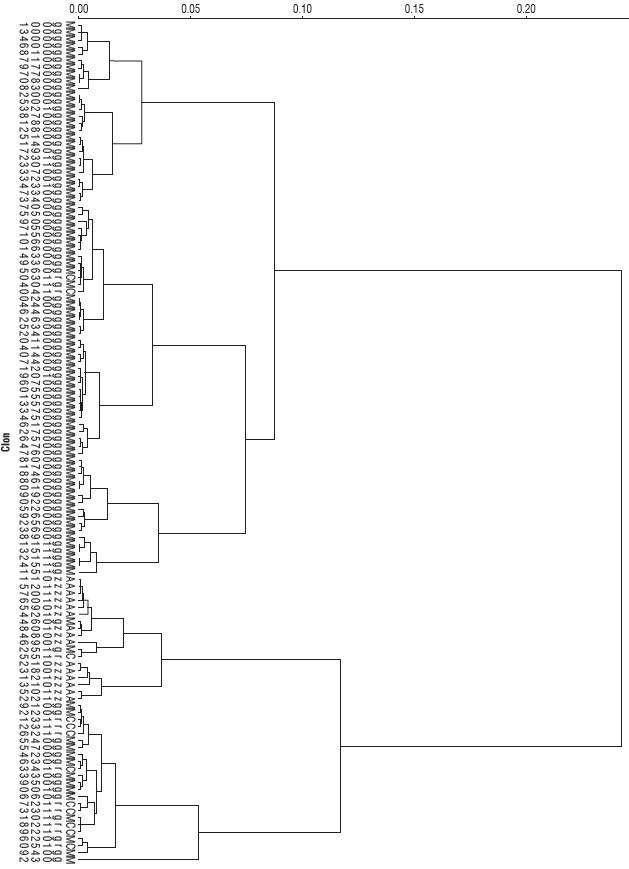
FIGURE 2 Dendrogram analysis of the cluster classification of 120 Margaritera orange genotypes collected at the Mompox depression. Data were obtained from PCA.
According to Orduz et al. (2010), seasonal changes related to rainy and dry seasons increase the environment average temperature and light radiation rates; a further decrease in these environmental ranges affects several physical properties such as growth, phenology (Guadalupe et al., 2018) and development behavior, and some quality characteristics, including the juice color range, sugar content and the acidic ratio (that establishes if it is pleasant for the palate) (Vélez et al., 2012).
Armadans et al. (2014) and Hernández et al. (2014) stated that citric quality is influenced, in addition, by numerous factors such as soil, fertilization, cultural practices, phytos-anitary treatments and the graft-holder, which suggests that fruit quality can be improved under tropical conditions.
Selection of outstanding clones based on the Colombian technical standard NTC4086
According to the NTC4086 parameters, GI genotypes were classified as fruits caliber D (FD between 62-71 mm) and GII and GIII genotypes were classified as fruits caliber C (DF between 72-83 mm). Fruit quality ranges were assigned according to Orduz et al. (2011), who reported that first quality oranges are those fruits above 230 g. GI and GII genotypes (183.73 g and 217.38 g, respectively) were classified as small fruits, while genotype GIII (270.79 g) was considered as first quality line. All three groups show JP<40%, TSS>8.2 °Brix, TA<1.5% citric acid, and MI>5.5. Despite the fruit quality is not appropriate to many international industrial markets due to the low juice acidity, the non-fulfillment of many requirements demanded in the NTC4086 is not an impediment for the fruit commercialization in the region.
Taking into account the afore-mentioned, we used the selection index proposed in equation 1 to select within each group the genotypes that are closest to comply with the requirements registered in NTC4086. As a result, approximately 7% of the genotypes of each group were selected among the genotypes that show the highest SI. The selected genotypes were: group I (Mar015, Mar037, Mar063 and Mar070), group II (Cr126 and Cr132) and group III (Az108 and Az122).
Moreover, the selected genotypes from group I belong to the traditional clone known as orange Margarita; these clones are characterized by showing small fruits (Caliber D) with a juice percentage higher than 40%, TSS>8.2 °Brix and TA>0.80% citric acid. The two genotypes selected from group II belong to the Criollo clones produced by seed, and are characterized by showing larger fruits (Caliber C) and higher weights, with a JP higher than 39%, TSS>8.2 °Brix and TA>0.64% of citric acid. Finally, the genotypes selected from group III belong to the clone Azúcar range farther from the requirements demanded in the NTC4086. However, it is a highly demanded clone by local producers and general consumers for fresh consumption and is characterized mainly by its high sugar concentration (TSS>9 °Brix) and low titratable acidity (TA<0.2% citric acid) (Tab. 5). The selected genotypes from groups I and II are those suggested to be offered to nurseries of the region as these show features that comply with the attributes reported in the NTC4086. Furthermore, the selected genotypes from group III are suggested to be considered for special fruit orders that require high TSS concentrations and low TA. It is important to note that the suggested genotypes still show a MI higher than the reported in the NTC4086. However, considering that Margaritera orange is mainly produced to supply fresh consumption markets, and following the statements by Sartori et al. (2002), the desired MI for this fruit ranges between 8.8 and 15.4, highlighting the fact that the MI reached by the genotypes of the GI and GII corresponds mainly to fruits in a maturation state 4-5 (MI = 9.8-11.8).
TABLE 5 Characteristics of the selected genotypes with the highest IS.
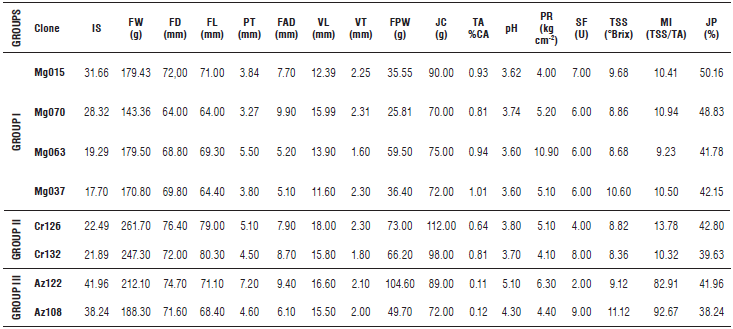
In addition to the genotypes selected for quality attributes, the Marg032 genotype was identified as seedless, making it an alternative for improvement processes, considering the great interest of some markets to acquire seedless fruits.
It is important to indicate that the genotypes characterized in the research, except for the Criollo genotypes that are produced by seed, are all grafted onto a bitter orange (Citrus aurantium L.) rootstock, which is a condition for the genotypes to show the features identified in the characterization. In this regard, the rootstock influences more than 20 horticultural characteristics of the grafted variety such as yield, longevity, nutrient adsorption, size, shape, color, internal and external fruit quality, tolerance to diseases, and adaptation to soil and climate conditions (Davies and Albrigo, 1994). Moreover, it might contribute more than any other factor to the success or failure of the citrus industry in any region of the world (Wutscher and Bistline, 1988). In addition, studies carried out by Chaparro-Zambrano et al. (2015) on the behavior of Valencia orange grafted in different rootstocks in the low tropics of Colombia showed as a result that the Sunky x English pattern contributed to a high maturity index ratio (TSS/ TA = 15.82ab) compared to rootstocks C-35 (13.74ab), Carrizo (IM = 14.39ab), Swingle (IM = 14.83ab), Citrumelo or CPB4475 (IM = 13.2ab), Cleopatra (IM = 13.19b), Volka-merian (IM = 11.44b), Webberi (IM = 12.51b) and Yuma (IM = 12.85b). Additionally, in the year 2017 the same authors found statistically significant differences between TSS and MI in juice of Arrayana tangerine grafted onto six rootstocks (Carrizo, Citrumelo Swingle, Cleopatra, Sunky x English, Sunky x Jacobson and Volcameriana). Other studies carried out in Mexico established that among a group of 20 rootstocks, Flying Dragon, Mandarina Cleopatra, Sacaton, Yuma, Morton, Rubidoux and Troyer confer the same quality to the fruit of Valencia orange than the one achieved with the bitter orange tree (Uribe-Bustamante et al., 2013). Simultaneously, Parameshwar et al. (2018) report that Rough Lemon (C. limon Linn. Burn) rootstocks have an effect on tree growth and the quality of fruit in Valencia Late orange. Rootstock effects on lemon fruit production and quality were assessed by Legua et al. (2018) reporting that the rootstock Forner-Alcaide 2324, Forner-Alcaide 418 and Forner-Alcaide 5 influenced fruit quality in lemon cultivars ('Fino 49' F49, 'Verna 50' V50 and 'Fino Elche' FE). In contrast, Da Silva et al. (2018) reported that the quality of navel orange "caracara" was not influenced by any of the evaluated rootstocks (Rangpur lime, 'Florida' rough lemon, 'Volkamer' lemon, 'BRS Tropical Sunki' mandarin, 'Indio' citrandarin, 'Vangasay' rough lemon). The above mentioned allows us to consider the possibility of multiplying the selected clones and grafting them on other rootstocks that can improve the internal and external fruit quality.
Conclusions
Significant differences were found between morphological and fruit quality characteristics of the Margaritera orange. One-hundred and twenty genotypes of Margaritera oranges were selected at the Mompox depression, 92 belonging to the Margarita clone, 15 to the Azúcar clone and 13 to the Criollo clone. The genotypes were morphologically characterized and grouped based on 14 quantitative characteristics, forming three different phenotype sets, grouped with a dissimilarity value of 10. Five main components were established, which explain 78.82% of the variability of the cultivars, being the first component the one that explains the greatest percentage of variability with 38.41%.
Among three Margaritera orange clones studied, eight outstanding genotypes were selected, which became the main source of propagation material for nurseries in the region when carrying out Margarita orange multiplication processes, thus, guaranteeing the origin of the material produced.
The three selected clones become an alternative for nurseries in the region to start the establishment of basic orchards for propagation material, in accordance with resolution ICA 0004215 of 2014.
It is necessary to evaluate the behavior of the selected Margaritera orange clones with other rootstocks, which confer better productivity characteristics, fruit quality and tolerance to excess moisture.













